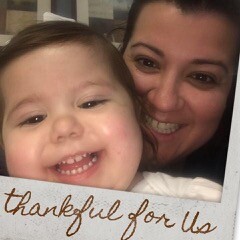- Adult Heart DiseaseDiseases of the arteries, valves, and aorta, as well as cardiac rhythm disturbances
- Pediatric and Congenital Heart DiseaseHeart abnormalities that are present at birth in children, as well as in adults
- Lung, Esophageal, and Other Chest DiseasesDiseases of the lung, esophagus, and chest wall
- ProceduresCommon surgical procedures of the heart, lungs, and esophagus
- Before, During, and After SurgeryHow to prepare for and recover from your surgery
September 27, 2017
Rileigh Elizabeth Faith Rogers was born on January 16, 2015, via C-section in San Antonio, TX. She was born with a congenital heart disease known as hypoplastic left heart syndrome (HLHS). In HLHS, the heart’s left side, including the aorta, aortic valve, left ventricle, and mitral valve, is underdeveloped. The cause of HLHS is unclear, and there are no known risk factors for this disease. HLHS is not preventable.

The journey begins
Our journey with Rileigh began when I was 21 weeks pregnant. During an ultrasound, the technician noticed that she did not have all of the ventricles that a normal child should have. After that, specialists followed her progress and watch for the development of other defects.
In order for her to survive, Rileigh would need three life-saving surgeries. Her first operation, the Norwood, was performed when she was only 6 days old. Rileigh spent the next 3 months in the NICU being monitored and having her medications regularly tweaked before she was able to come home.
When Rileigh was 6½ months old, she had her second operation—the Glenn Shunt. This time, she was in the hospital for almost 2 weeks. Everything went well, and she was thriving. Rileigh was able to be a normal baby, trying to crawl and eating just like other 7-month-old babies.
A life-changing decision
A few months into the following year, we found out that our daughter would need a heart transplant in order to survive. In March 2016, Rileigh was going into heart failure and had to take medication just to keep her heart going. This was the darkest time that my husband and I experienced. My heart was crushed. I prayed that Rileigh and her heart would get better, but nothing changed.
We spoke with the cardiologist who said that there wasn’t much else they could do, and he wasn’t sure how much more time she would have with us. I could not accept that as the final answer. So I searched for different doctors and sought a second opinion.
By May, Rileigh was sick again, forcing us to decide about the heart transplant. There were so many things that were keeping my husband and me from agreeing to a transplant. I was afraid of losing Rileigh on the operating table or losing her before a heart even became available. We finally decided to move forward with the workup for the transplant. More doctors visits, consultations with the transplant team, lab work, and echocardiograms were needed before transplant approval.
Rileigh was approved for a heart transplant in July 2016. The next month, we moved approximately 200 miles to Houston; the waiting game began. Every day that passed was precious. We were in Houston for 6 months. While there, we visited with old friends and made new ones. We brought Rileigh trick-or-treating for Halloween. We moved through every day; but every night in the hotel, I would pray that God would give us another day with Rileigh until a heart became available. I was not ready to let her go. I wanted to see her grow and do amazing things with her life.
Rileigh’s new heart
Then the day came. I received the life-changing call from the transplant team, telling us that they had a heart for Rileigh. At that moment, my life came to a complete standstill. I could not breathe. I cried like a baby. I knew that God was listening and had answered our prayers. Dr. Lauren Kane led the incredible team that performed Rileigh’s heart transplant operation.

From the time that they took her to the OR until she was out of surgery, time was dragging. Those were the longest moments of my husband’s and my life. Besides thinking of her being back in the operating room, I also was wondering about her heart. Was the new heart going to be a good match? Would the harvest team like what they saw when it did its evaluation? The heart finally arrived and, at 7:38 a.m., Rileigh’s new heart took its first beat in her body. I knew at that moment our lives would change in so many ways.
Life with Rileigh
Life now with Rileigh at home is amazing. She is doing all of the things that she was able to do before, but without getting tired. She is able to climb, walk, and is even trying to run. Rileigh loves being outside and playing with her siblings, swinging in her swing and going down the slide. She is full of life, sunshine, happiness, and smiles. I feel that there is nothing she cannot do. I am going to let Rileigh do whatever her heart desires and encourage her to follow her dreams.
When we left the hospital, it was scary. We felt first-time jitters again. I was afraid of doing something wrong, but I reminded myself that everything was okay. This was our new normal. I could not wait to get home to my family and kids who I missed so much.
Rileigh still has to undergo biopsies of her heart to check for signs of rejection. I have been told that the biopsies will get easier as time goes on, though I feel like it never gets easier. When we check in, I know that Rileigh is aware of what is happening or what is going to happen. She may be only 2 years old, but she is very smart.
When they take her back for the test, we kiss her and reassure her that we will be waiting for her once she wakes up. Since she was a baby, I also have always whispered in her ear to come back to me because I love her so much. Then the waiting game begins. This can be torturous because we just want to hear that everything is okay. We want to go home and return to our normal routine. We keep repeating to ourselves, “No rejection. No rejection.” I even fear talking with the doctor once they are done because I am afraid of what he is going say—will it be bad news or good news?
Even with these stresses, life is an incredible blessing. There are so many wonderful and talented people on Rileigh’s team. Life has changed for the better, with us remembering that every day is as precious as the next. I would have never dreamt of going through this with any of my children, but if I had to do it again, I would in a heartbeat.
Read more about pediatric heart transplantation.
The opinions expressed in this article are those of the author and do not necessarily reflect the views of The Society of Thoracic Surgeons.

